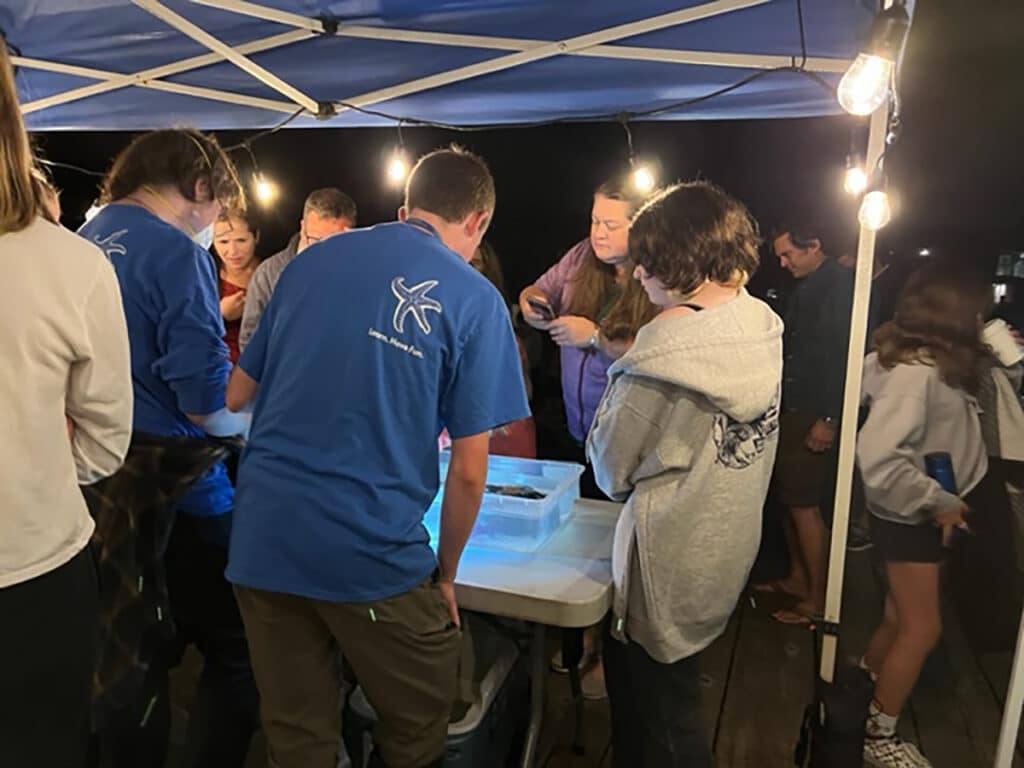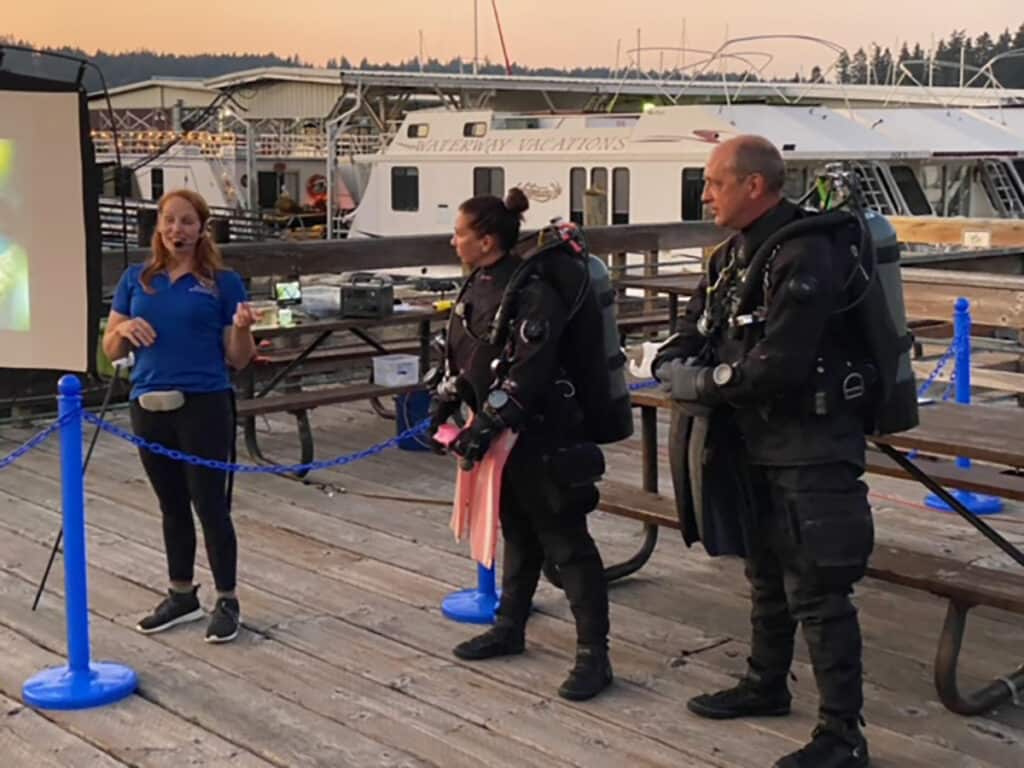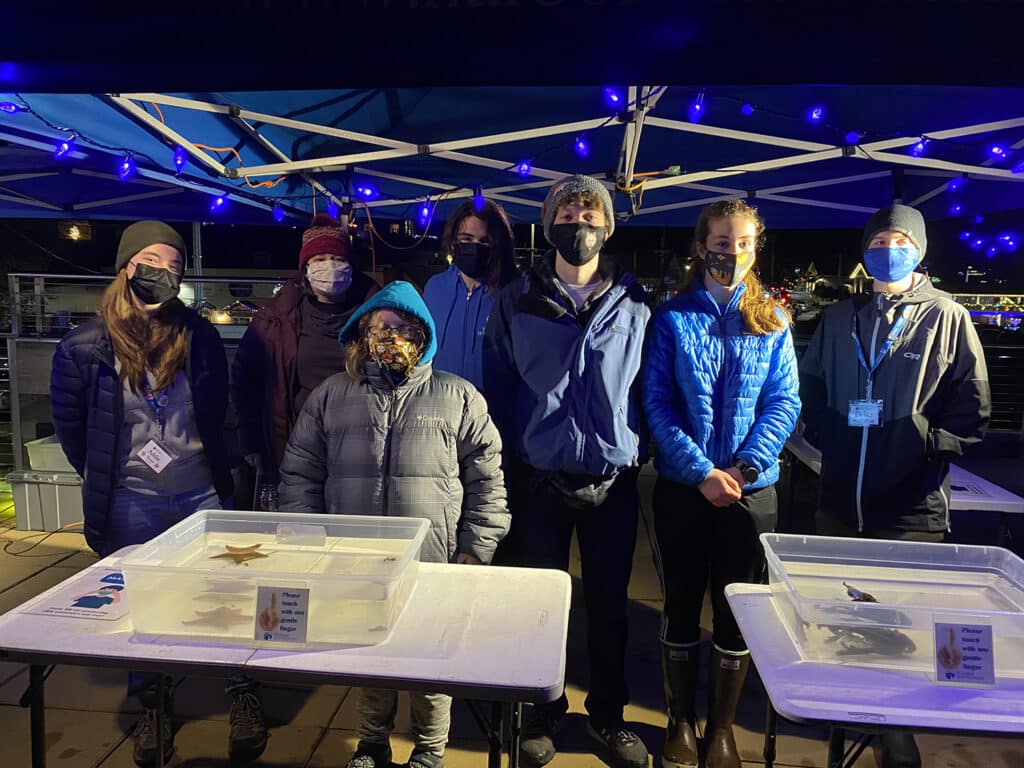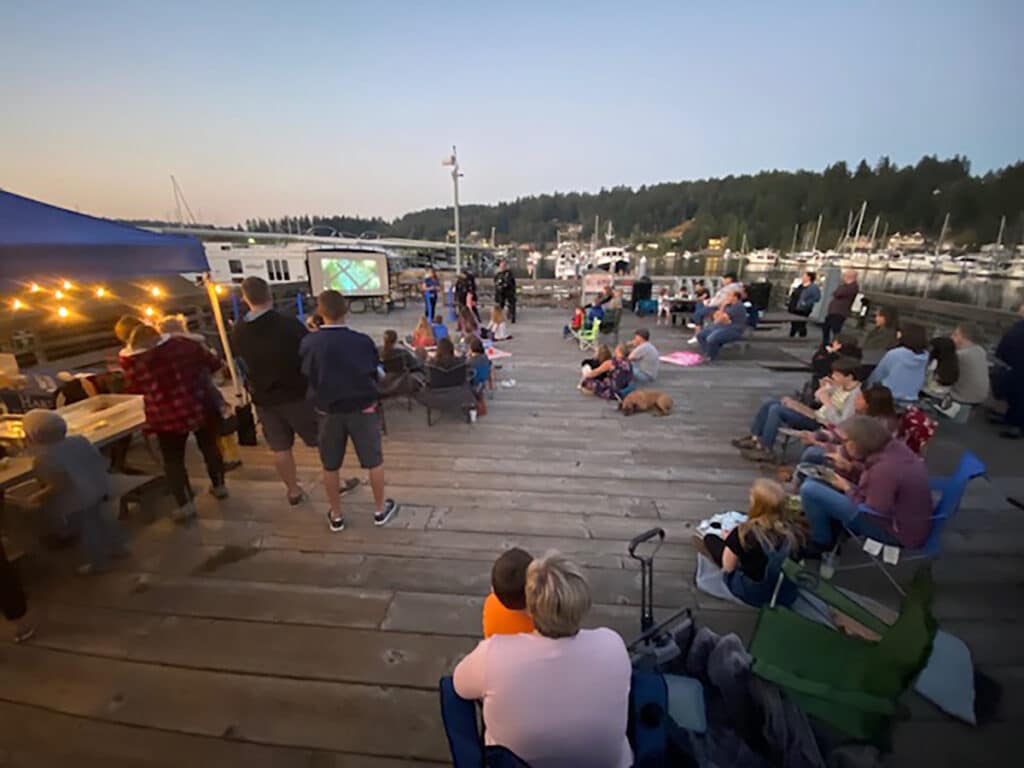Arts & Entertainment Community Environment
Pier Into the Night offers chance to see what lurks under the waves
Tubeworms, sea stars, and crabs are just a few examples of the critters that live in our water. A walk along the beach can reveal some of these creatures at low tide. But most beachcombers never get the chance to see them in the water.
They are just some of the sea life featured on the big screen during Harbor Wildwatch‘s Pier Into the Night events. The next one is at 6 p.m. Saturday, Nov. 5, at Jerisich Park in Gig Harbor. The nonprofit hosts Pier Into the Night on the first Saturday of each month from October to March.
Harbor WildWatch also brings educational programs to public school classrooms in the Peninsula School District, as well as private schools. But these public events are a way for adults and homeschooled students to learn about marine life in Puget Sound.

Attendees get a glimpse of marine life during a previous Pier Into the Night at Jerisich Dock in Gig Harbor. Harbor WildWatch
A look under the waves
Pier Into the Night is one more way that Harbor Wildwatch has been spreading the word about the fragile ecosystem since the nonprofit formed in 2004. Its headquarters are now at the Skansie House in Gig Harbor at Skansie Brothers Park and Netshed on Harborview Drive.
Rachel Easton joined the team in 2007 as education director and has implemented many programs over the years. Pier Into the Night is the most recent addition to the program repertoire: A chance for attendees to get up close with marine life through touch tanks, and also watch on a big screen as divers with cameras provide a view that most never get to see.
“We do this (Pier Into the Night) in all weather, and every time it’s pouring rain, and just when I think no one is coming … there will be 12 people,” she said. “Volunteer divers use a submersible drone underwater, and they go under the dock to point out interesting things. They will bring animals over, like shrimp and tubeworms. They have 300 feet of cable to check out the storm drain, and we get to see what is flowing out of that into our bay.”
Meet the divers
Certified divers Allen and Brook Raphael have been volunteering with the Pier Into the Night program since 2014. Allen is a photographer by trade.
They arrive early and mingle with the crowd, answering questions about diving and their gear.

SCUBA divers are introduced before they jump into the harbor in search of marine life. Harbor WildWatch
“Then we jump in the water and swim around showing off the life underneath the docks, the tubeworms that are down there,” Allen Raphael said, “and multiple kind of crabs in that 15-20 feet of water there off the dock, the anemones that grow, and some urchins here and there.”
Two naturalists remain on the dock to narrate the underwater adventure.
“We have no idea what they are saying, and we play it by ear before we move on to the next animal,” Allen said. “We also will highlight garbage and debris and make it goofy, talk on the cell phone, or put the sunglasses on.”
Raphael said narrators Rachel Easton and Steena Troyer discuss the perils of water runoff and how actions like washing a car without collecting runoff can decrease water quality.
“We swim around for half hour or 40 minutes at most, and go to all the small fish in that area,” Allen said. “If we’re lucky see a small octopus, and Brook will get out first and answer more questions, live on-the-spot questions, about what we saw, and then Rachel and Steena will give more scientific information about what the animal is and fun quirky facts about it.”
WildWatch relies on volunteers
Harbor WildWatch relies on volunteers to help with the programs, and Easton said about 60 volunteers are on the roster. One of the younger volunteers has been participating since he was in elementary school.
Eamon Keating, a sophomore at Tacoma Public School’s Science and Math Institute, has always been interested in marine animals. When his second grade teacher told him about Harbor Wildwatch, it was a natural fit.

Touch tanks at a Harbor WildWatch Pier Into the Night event. Harbor WildWatch
Eamon started in the Sea Stars and Beyond program, said his mother, Jessie Keating. He has just continued to progress as he’s gotten older.
“We are known as the crazy family. … We spend half the night on the beach, and he gets to do fun things with the scientists, then we have breakfast in the morning,” she said.
Eamon said on the winter and summer solstice when the tides are low, they all participate in a type of beach monitoring, and do something called “presence/absence” counting. It’s part of the beach monitoring program, said Easton, where scientists collect biodiversity data.
“Our goal with the program is to establish a baseline, and be able to track changes over time,” Easton said.
Not just a day on the beach
Volunteers and staff members perform presence/absence counts in the middle of the night, Eamon said. So he and his family don layers of clothing when they do the important work of monitoring.
“We set up a measuring tape, a couple hundred meters, and we time it for the lowest tide of the year. The winter one is a little less popular (with volunteers), so it’s more important that my family goes,” he said.

A crowd at Jurisich Dock for a previous Pier Into the Night event. Harbor WildWatch
That time of year is quite cold, but his family does it every year. “We go down (on the beach) and have someone stand at the 3 meter mark and within a meter on each side we call out whatever species we see present, for instance, clam shell, living seaweed, shore crab. We make a game so whoever calls out first wins, but there isn’t a prize, really, it just makes it more fun.”
Both Eamon and his mother said that the work they do for Harbor WildWatch has been a great activity for their family.
“We really like the ocean and the underwater life, and it’s been kind of like a springboard to get involved in the conservation and education that we love to do, and work hands-on with animals that we wouldn’t normally be able to, and provided traditions that we do every year,” Eamon said.
“I could sing their praises all day,” Jessie Keating said of the organization. “I think it’s a really fun way to do something kind of unexpected. I’m so grateful to Harbor WildWatch.”
Pier Into the Night
When: Saturday, Nov. 5
Time: 6 p.m.
Where: Jerisich Park, Gig Harbor
